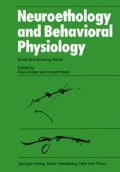Abstract
An understanding of how physiological systems cope with environmental challenges came about through the recognition by Claude Bernard in the last century that living organisms have two environments: the outer physical environment and an internal environment comprised of the fluids that bathe the cells of an organism. In considering behavior, one must similarly be cognizant of the fact that the nervous system is confronted with the same two environments and that both have an impact on the behavior that the animal eventually shows. As indicated by the preceding papers in this section, it is clear that chemicals constitute an important set of cues to inform an animal about the state of its external environment. Information about the internal environment is likewise conveyed to the central nervous system (CNS) in the form of chemical signals.
Access this chapter
Tax calculation will be finalised at checkout
Purchases are for personal use only
Preview
Unable to display preview. Download preview PDF.
References
Arnold AP, Nottebohm F, Pfaff DW (1976) Hormone concentrating cells in vocal control and other areas of the brain of the zebra finch (Peophila guttata). J Comp Neurol 165: 487–512
Blest AD (1960) The evolution, ontogeny and quantitative control of the settling movements of some New World Saturniid moths, with some comments on distance communication by honeybees. Behaviour 16: 188–253
Carlson JR (1977a) The imaginal ecdysis of the cricket (Teleogryllus oceanicus), I. Temporal structure and organization into motor programmes. J Comp Physiol 115: 299–317
Carlson JR (1977b) The imaginal ecdysis of the cricket (Teleogryllus oceanicus), II. The role of identified motor units, and control by sensory and central factors. J Comp Physiol 115: 319–336
Davidson JM, Levine S (1972) Endocrine regulation of behavior. Annu Rev Behav 34: 375–408
Harris GW, Michael RP, Scott PP (1958) Neurological site of action of stilboesterol in eliciting sexual behavior. In: Wolstenholme GE, O’Connor CM (eds) Ciba Found Symp Neurolog Basis of Behavior. Little Brown, Boston, p 236–251
Haskell PT, Moorehouse JE (1963) A blood-borne factor influencing the activity of the central nervous system of the desert locust. Nature 197: 56–58
Hughes TD (1980) The imaginal ecdysis of the desert locust, Schistocerca gregaria. I. A description of the behavior. Physiol Entomol 5: 47–54
Kammer AE, Kinnamon SC (1979) Maturation of the flight motor pattern without movement in Manduca sexta. J Comp Physiol 130: 29–37
Lehrman DS (1955) The physiological basis of parental feeding behavior in the Ring Dove. Behaviour 7: 241–286
Levine RB, Truman JW (1982) Metamorphosis of the insect nervous system and changes in the morphology and synaptic interactions of identified cells. Nature 299: 250–252
Milburn N, Weiant EA, Roeder KD (1960) The release of efferent nerve activity in the roach, Periplaneta americana, by extracts of the corpus cardiacum. Biol Bull 118: 111–119
Morrell J, Kelley D, Pfaff DW (1975) Sex steroid binding in the brains of vertebrates: studies with light microscopic autoradiography. In: Knigge K, Scott D, Kobayashi H, Ishii S (eds) Brain-endocrine interactions vol II. Karger, Basel, pp 230–256
Reynolds SE, Taghert PT, Truman JW (1979) Eclosion hormone and bursicon titres and the onset of hormonal responsiveness during the last day of adult development in Manduca sexta (L). J Exp Biol 78: 77–86
Riddiford LM (1983) Hormone action at the cellular level. In: Kerkut GA, Gilbert LI (eds) Comprehensive insect physiology, biochemistry and pharmacology. Pergamon, Oxford New York (in press)
Schwartz LM, Truman JW (1983) Hormonal control of the rates of metamorphic development in the tobacco hornworm, Manduca sexta. Dev Biol (in press)
Taylor HM, Truman JW (1974) Metamorphosis of the abdominal ganglia of the tobacco hornworm, Manduca sexta: changes in populations of identified motor neurons. J Comp Physiol 90: 367–388
Truman JW (1976) Development and hormonal release of adult behavior patterns in silkmoths. J Comp Physiol 107: 39–48
Truman JW (1978) Hormonal release of stereotyped motor programmes from the isolated nervous system of the Cecropia silkmoth. J Exp Biol 74: 151–174
Truman JW, Riddiford LM (1970) Neuroendocrine control of ecdysis in silkmoths. Science 167: 1624–1626
Truman JW, Sokolove PG (1972) Silkmoth eclosion: hormonal triggering of a centrally programmed pattern of behavior. Science 175: 1491–1493
Truman JW, Taghert PH, Reynolds SE (1980) Physiology of pupal ecdysis in the tobacco hornworm, Manduca sexta. I. Evidence for control by eclosion hormone. J Exp Biol 88: 327–337
Truman JW, Taghert PH, Copenhaver PF, Tublitz NJ, Schwartz LM (1981) Eclosion hormone may control all ecdyses in insects. Nature 291: 70–71
Truman JW, Rountree DB, Reiss SE, Schwartz LM (1983) Ecdysteroids regulate the release of eclosion hormone in moths. J Insect Physiol (in press)
Author information
Authors and Affiliations
Editor information
Editors and Affiliations
Rights and permissions
Copyright information
© 1983 Springer-Verlag Berlin Heidelberg
About this paper
Cite this paper
Truman, J.W. (1983). Insect Ecdysis: A System for the Study of Internal Chemicals That Control Behavior. In: Huber, F., Markl, H. (eds) Neuroethology and Behavioral Physiology. Springer, Berlin, Heidelberg. https://doi.org/10.1007/978-3-642-69271-0_12
Download citation
DOI: https://doi.org/10.1007/978-3-642-69271-0_12
Publisher Name: Springer, Berlin, Heidelberg
Print ISBN: 978-3-642-69273-4
Online ISBN: 978-3-642-69271-0
eBook Packages: Springer Book Archive

